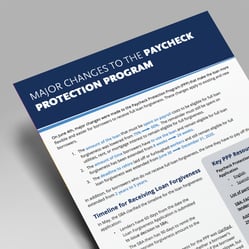On June 4, 2020, three major changes were made to the Paycheck Protection Program (PPP) loan forgiveness program to make it more flexible and less burdensome for borrowers to receive full loan forgiveness. These changes apply to new borrowers and those who already received their loan, and should make it easier for PPP loan recipients to have their loan completely forgiven by the Small Business Association. This added flexibility is particularly helpful for businesses that are still not fully operational.
1. The payroll rule to be eligible for full loan forgiveness changed from 75% to 60%.
Originally, borrowers were required to spend at least 75% of the loan on payroll costs for the loan to be fully forgiven. Payroll costs include staff wages, health insurance, retirement contributions, sick and vacation leave, and state and local taxes. Now, only 60% must be spent on payroll. To be eligible for full loan forgiveness, the remainder must still be spent on utilities, rent, and mortgage interest.
2. The amount of time borrowers have to use the loan has been extended from 8 weeks to 24 weeks.
Originally, the PPP rules required borrowers to use the loan in 8 weeks to be eligible for full loan forgiveness. Borrowers now have 24 weeks to spend the PPP loan and still be eligible for full loan forgiveness.
3. The deadline to rehire laid off or furloughed workers has been changed from June 30 to December 31, 2020.
Previously, to receive full loan forgiveness, borrowers only had until June 30th to rehire laid off or furloughed employees or fully restore reduced wages. Now, borrowers have until the end of the year. This flexibility is particularly important for businesses who will not be operating at full capacity by June 30th.
In addition, for borrowers who do not receive full loan forgiveness, the time they have to pay off the loan was extended from 2 years to 5 years.
Another key rule for loan forgiveness for the PPP was clarified by the SBA in May. To the question of whether a borrower’s PPP loan forgiveness amount will be reduced if the borrower laid off an employee, offered to rehire the same employee, but the employee declined the offer, the SBA has clearly answered “no.” The SBA and Treasury have stated they will exclude laid-off employees whom the borrower offered to rehire. To qualify for this exception, the borrower must have made a good faith, written offer of rehire, and the employee’s rejection of that offer must be documented by the borrower. Employees and employers should be aware that employees who reject offers of re-employment may forfeit eligibility for continued unemployment compensation.
In May, the SBA also clarified the timeline for forgiveness application:
- Lenders have 60 days from the date the Loan Forgiveness Application is submitted to issue decision to SBA;
- The SBA then has 90 days to remit the appropriate forgiveness amount to the lender.
Additional guidance effective May 29.
- SBA reviews of individual PPP loans
- The loan forgiveness process for lenders
Key PPP resources:

- Paycheck Protection Program Application (English) / (Spanish)
- Loan forgiveness application (English) / (Spanish)
- List of participating lenders
- SBA: FAQ for borrowers and lenders
- Official guidance addressing SBA reviews of individual loans
- From CCAoA: Click here for a one-page summary PDF of these changes and resources.





